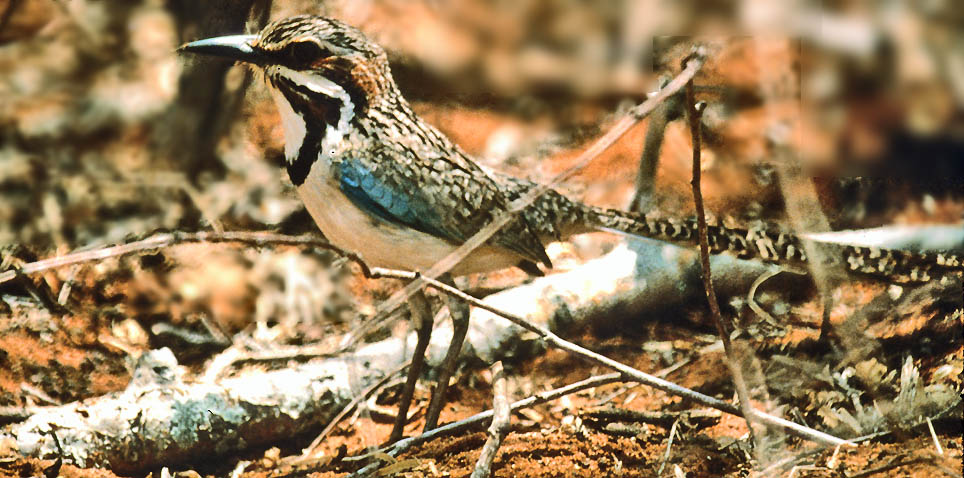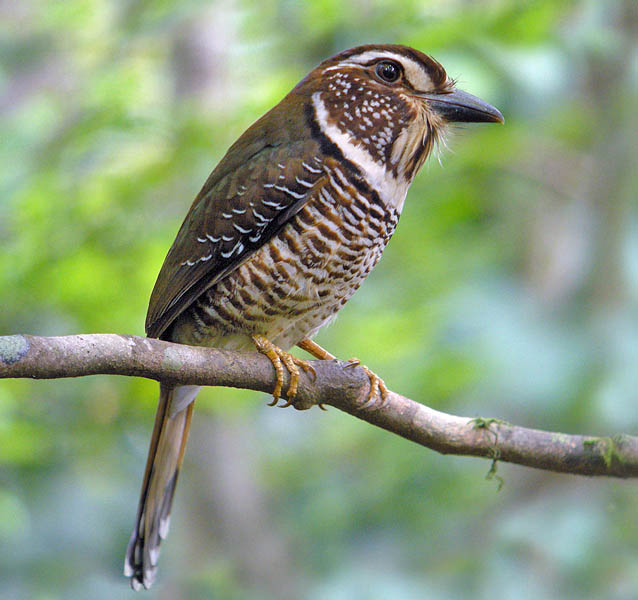
a web page by Don Roberson |
GROUND-ROLLERS Brachypteraciidae |
|
Given a restricted range, small population, and retiring habits, its specific epitaph is "chimaera" — an elusive and perhaps nonexistent ghost. Morris & Hawkins (1998) state that "without the assistance of local guides the species can be very difficult to locate." Bird tours hire locals to take them to territorial pairs in the red-earthed spiny desert. So it was that I was fortunate to photograph this one, back in the days before digital cameras. While the glistening sky-blue wing coverts and terrestrial behavior recalls pittas, the long tail and preference for running on the red earth reminds me of American roadrunners. Yet, when on is flushed to a perch, and cocks its tail up slowly, it is nothing so much as a gigantic Australasian fairywren! It is restricted to sandy deserts of cactus-like Didierea madagascariensis and the succulent Euphorbia stenoclada (Dee 1986) where it lays its eggs at the end of a three-foot burrow dug in the sand. All in all, what a bird! |
 |
| The Ground-Rollers are evolved among the Coraciiformes, and its closest relative are the Rollers (Coraciidae); Hackett et al. (2008). They diverged from Rollers about 34 million years ago (Prum et al. 2015). |
Now, of course, digital photography has made it possible to capture striking images of this and other ground-rollers. Although I've updated this web page for its 1999 original, I've left in this effort at field sketching and field description to remind myself what it was like back then. |
These remaining ground-rollers are Rufous-headed Ground-Roller Atelornis crossleyi (which I had the good fortune to see at Ranamanfana) and Scaly Ground-Roller Brachypteracias squamiger. Each is spectacular, elusive, and prized — one runs out of superlatives in talking about this family. The most distinctive Ground-Roller call is a far-carrying territorial cry. These are given only before and during the breeding season (usually Sep-Feb). Ground-Rollers are so reclusive when not calling that "local human inhabitants are reported to believe that these birds hibernate in burrows, in the manner of certain Malagasy mammals, when not breeding;" Langrand (2001). At all times, Ground-Rollers are almost exclusively terrestrial, searching through the leaf-litter for invertebrates and chameleons, frogs, lizards and snakes. |
Photos: The photos of Long-tailed Ground-Roller Uratelornis chimaera were taken near Ishfay, north of Tulear, Madagascar, on 20 Nov 1992. The sketch of Pitta-like Ground-Roller Atelornis pittoides was from the Ranamanfana Reserve, eastern Madagascar, on 26 Nov 1992. Frank Vassen photographed the Short-legged Ground-Roller Brachypteracias leptosomus at Masoala NP, Madagascar, on 6 Dec 2008. Uncredited photos © Don Roberson. Credited photos © Frank Vassen, as credited, and used under license by Wikipedia Common; all rights reserved. Bibliographic note: There is no "family book" but a fine introduction to this family, with some lovely photos, is in Langrand (2001). In addition, spectacular photos of all five ground-rollers are in Morris & Hawkins (1998) and their habitats covered by Dee (1986). Literature cited:
|
 The
Ground-Rollers are a unique family of five distinctive species found
only in Madagascar. Four of them occur in the rainforest of the eastern
escarpment; the fifth is found only in the spiny deserts of the
southwest. This latter bird is the fantastic Long-tailed Ground-Roller
(left and below). It is one of my all-time favorite birds. It has been
so ever since Stuart Keith (1974) listed it (with Congo Peafowl, Great
Argus) as the three most "elusive" birds on earth. That has changed but
it is still wonderful
The
Ground-Rollers are a unique family of five distinctive species found
only in Madagascar. Four of them occur in the rainforest of the eastern
escarpment; the fifth is found only in the spiny deserts of the
southwest. This latter bird is the fantastic Long-tailed Ground-Roller
(left and below). It is one of my all-time favorite birds. It has been
so ever since Stuart Keith (1974) listed it (with Congo Peafowl, Great
Argus) as the three most "elusive" birds on earth. That has changed but
it is still wonderful  The
remaining ground-rollers are elusive forest birds, each most easily
located by vocalizations and each impressive in its own way. I made
this pencil sketch of a Pitta-like Ground-Roller
(right) shortly after observing it in the field. It responded to a
taped call in wet tangled forest, hopped up to an eye-level branch, and
began calling. As it gave each deep "whop" note, it dipped its
head to its breast and wagged its tail. This sketch is in
black-and-white out of my field notebook, but the bird itself was
striking. The throat and supercilium were gleaming white, setting off
the black mask through the eye & face. The white throat was
bordered in deep blue, which itself was crisply demarcated from an
orange upper breast and neck. The crown is blackish (dotted white) and
the back green. The belly was white and legs bright pink. A very
colorful but very elusive bird, looking like a giant overgrown pitta
(from whence the English name), but still oddly different.
The
remaining ground-rollers are elusive forest birds, each most easily
located by vocalizations and each impressive in its own way. I made
this pencil sketch of a Pitta-like Ground-Roller
(right) shortly after observing it in the field. It responded to a
taped call in wet tangled forest, hopped up to an eye-level branch, and
began calling. As it gave each deep "whop" note, it dipped its
head to its breast and wagged its tail. This sketch is in
black-and-white out of my field notebook, but the bird itself was
striking. The throat and supercilium were gleaming white, setting off
the black mask through the eye & face. The white throat was
bordered in deep blue, which itself was crisply demarcated from an
orange upper breast and neck. The crown is blackish (dotted white) and
the back green. The belly was white and legs bright pink. A very
colorful but very elusive bird, looking like a giant overgrown pitta
(from whence the English name), but still oddly different.  Digital
images now permit a greater appreciation for these spectacular birds.
To many birders they remain a best-kept secret because, having never
picked up a book about Madagascar, they are unaware of their existence.
This is Short-legged Ground-Roller (left) in a fine image by Frank Vassen.
Digital
images now permit a greater appreciation for these spectacular birds.
To many birders they remain a best-kept secret because, having never
picked up a book about Madagascar, they are unaware of their existence.
This is Short-legged Ground-Roller (left) in a fine image by Frank Vassen.